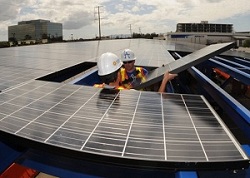Solar week in review: April Fool’s edition
 All solar incentives in the U.S. are over and Germany has decided to return to coal as its primary power source. That would be the start of this if it were an April Fool’s hoax, but it’s not. The past week was too eventful for solar for that. From states moving on clean energy legislation—some good, some bad—to localities making solar a required option, to new or more more efficient solar technologies making waves in the headlines, it was an eventful week.
All solar incentives in the U.S. are over and Germany has decided to return to coal as its primary power source. That would be the start of this if it were an April Fool’s hoax, but it’s not. The past week was too eventful for solar for that. From states moving on clean energy legislation—some good, some bad—to localities making solar a required option, to new or more more efficient solar technologies making waves in the headlines, it was an eventful week.
First off, Minnesota is considering legislation to incentivize solar by making the rates its utilities must pay for solar higher than the rates they pay for other electric generation. The state would require utilities to pay the full ‘value of solar’. That means the rates utilities pay for solar would include the addition cost-reductions that solar provides, including reduced transmission line costs and infrastructure investments that are offset by locally generating solar.
While that could be good for solar, legislation being considered in Ohio would be bad for it. Like North Carolina, the recently introduced legislation would repeal the state’s renewable energy portfolio, which currently requires utilities to step up their purchases of renewable energy until they source 12.5 percent of their electric generation from renewables by 2025. The bill, if passed, could be ruinous to that state’s solar industry.
The story’s a little different in California, however. Last week Lancaster, Calif., became the first municipality in the U.S. to require solar on all new residential buildings. Starting in January 2014, the city is requiring all new residences to carry an average minimum of a 1 kilowatt. That means that a company developing a project could still have some residences without solar as long as others in the development have enough to meet that minimum.
Over in San Diego it’s looking sunny for solar, too. When completed the Solterra EcoLuxury Apartments in Scripps Ranch will become the city’s first 100 percent PV-powered apartment buildings. People are expected to start moving into the 114 apartments as soon as May. It may also be the first time in the U.S. that an apartment complex has gone 100 percent solar-powered.
On the tech side of things, the coolest solar news—literally—is a new device from Stanford University that reflects and refracts solar’s thermal heat and sends it back through earth’s atmosphere and into outer space, avoiding the greenhouse effect. The device does all of this passively, so no electricity is needed for it to provide cooling. The researchers at Stanford could see the devices being applied to buildings to help them keep cool without using air conditioning.
Another efficiency record for a solar cell also fell last week, thanks to Alta Devices’ latest research. Their new dual-junction thin-film PV device reached 30.8 percent solar cell conversion efficiency in March. The results were verified by the National Renewable Energy Laboratory (NREL). Alt Devices has a much loftier goal in mind for its technology. PV cells that are 38 percent efficient cells, the company said.
Another tech company announced a different type of solar record last week, Apple. The tech giant issued its updated environmental report for 2012, in which it announced that it has the largest privately owned PV array, the 20 megawatt array at its data center in Maiden, N.C. The company now sources 75 percent of all its energy across all its corporate facilities from renewables. It also said it plans to source 100 percent of its energy from clean energy soon and will install another 20 megawatts at the Maiden facility.



